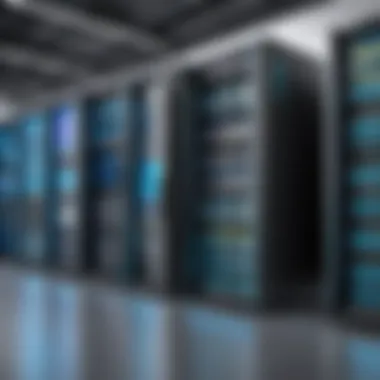Understanding Mainframe Computers: In-Depth Analysis


Intro
Mainframe computers, once seen as the backbone of enterprise computing, remain integral to various sectors today. They are robust systems designed for large-scale computing tasks, capable of handling vast amounts of data and numerous simultaneous transactions. Understanding mainframes includes exploring their architecture, evolution, and operational framework. This article aims to dissect these remarkable machines, revealing their advantages and challenges while highlighting their relevance in the current technological landscape.
Performance Metrics
Performance is a critical consideration when assessing mainframe computers. Their ability to manage workloads efficiently determines their utility in organizational contexts.
Benchmarking Results
Benchmarking results provide valuable insight into how mainframes perform relative to other computing solutions. Standards such as the Transaction Processing Performance Council (TPC) metrics evaluate how well systems handle transactions. Mainframes excel in workloads that demand reliability and availability, with results often showing they can process millions of transactions in real-time.
Speed and Responsiveness
The speed of mainframes is another key performance metric. They typically leverage parallel processing, allowing for faster data handling. This efficiency contributes to responsiveness, which is essential for enterprises relying on real-time data. Mainframes deliver high throughput, making them suitable for critical applications such as banking and inventory management.
Usability and User Experience
While performance metrics are vital, usability also plays a significant role in the adoption of mainframe systems.
Ease of Installation and Setup
The initial setup of mainframes requires careful planning. Organizations must consider capacity needs and integration with existing systems. Although the installation process can be complex, modern mainframes have become more user-friendly, streamlining configuration processes that previously presented difficulties.
Interface Design and Navigation
Advancements in user interface design have greatly enhanced user experience. The interface of contemporary mainframes includes intuitive navigation tools, making it easier for users to manage tasks. Having a clear and efficient interface is crucial for IT staff who maintain system operations.
"Mainframes are essential for organizations needing reliability, speed, and efficiency in handling large volumes of transactions."
The Evolution of Mainframe Computers
The evolution of mainframe computers is fundamental to understanding their current role and significance in the technology landscape. These machines have a storied history, marked by innovation, resilience, and an adaptability that has allowed them to survive through decades of rapid change in computing. Examining the evolution of mainframe computers showcases their pivotal contributions to various industries, as well as the technological advancements that have shaped their capabilities.
Historical Background
The historical context of mainframe computers begins in the 1950s when they emerged as powerful tools for business and scientific calculations. Early models like the IBM 701 pioneered the use of electromechanical and electronic capabilities, which significantly outperformed their predecessors. The development of transistors in the 1960s further propelled their efficiency and reduced size, leading to the introduction of the IBM System/360 line, a revolutionary architecture that established standards for compatibility across different models.
During the decades that followed, mainframes began to integrate more advanced functionalities. They became central to operations in banking, insurance, and government sectors, driving large-scale data processing and management. This was not just a matter of increased performance; it also implicated changes in data security and centralized processing, which were crucial for handling sensitive information responsibly.
Key Milestones in Development
The journey of mainframe computers is punctuated by significant milestones, each reflecting shifts in technology and user demand.
- 1964: IBM System/360 Launch
The introduction of the IBM System/360 is often regarded as a watershed moment. It established a compatible family of computers that could run the same software, which allowed organizations to upgrade their hardware without losing their investments in applications. - 1970s: Virtualization Techniques
Advancements in virtualization allowed for multiple operating systems to run on a single mainframe, maximizing resource usage and enabling better efficiency. This set the foundation for modern cloud computing principles. - 1980s-90s: Client-Server Model Emergence
As personal computing became widespread, the client-server model emerged. Mainframes adapted by integrating with these networks, continuing to serve as robust back-end systems while facilitating connectivity. - 2000s: Linux on Mainframes
The adaptation of Linux on mainframe systems demonstrated their versatility and ability to integrate with modern open-source environments. This not only extended their lifespan but also opened new avenues for cost-effective enterprise solutions. - Present Day: Hybrid Environments
Today, mainframes are often part of hybrid cloud environments. They work alongside modern computing systems, benefiting from cloud scalability while still offering unmatched reliability and performance for critical applications.
By reflecting on these pivotal developments, it becomes clear that the evolution of mainframe computers is not merely a chronicle of technological change. It is a story of resilience, efficiency, and the relentless pursuit of innovation, ensuring their continued relevance in an ever-evolving digital landscape.
Architecture of Mainframe Computers
The architecture of mainframe computers serves as the foundational framework that defines their operation and capabilities. This topic is crucial for understanding how mainframes function and why they remain relevant in the modern computing landscape. Mainframe architecture integrates various components to achieve reliability, scalability, and high performance. Understanding these specifics allows IT professionals to harness the full potential of mainframe systems.
Hardware Components
Mainframe hardware components are unique and specifically designed to handle heavy workloads efficiently. These systems include processors, memory, input/output (I/O) devices, and storage subsystems.
- Processors: Mainframes utilize powerful central processing units (CPUs) optimized for transaction processing and data management. Often, they include multiple cores, allowing for simultaneous processing of numerous tasks.
- Memory: Mainframe memory is vast and can be expanded as needed. This enables effective multitasking and supports large datasets. The architecture typically includes both volatile and non-volatile RAM, ensuring quick data access and reliable storage.
- I/O Devices: I/O devices in mainframes are crucial for interaction with external systems. This includes network adapters, tape drives, and printers that are designed for high volume and speed.
- Storage Subsystems: The storage system often relies on a combination of high-speed disk drives and tape storage solutions. They provide flexible and reliable data storage options for massive amounts of data, crucial for many enterprise applications.
Mainframe hardware is architected to be fault-tolerant and ensure system uptime, giving businesses confidence that their systems remain operational.


System Software and Operating Environments
The operating system for a mainframe is a critical component of its architecture. It acts not only as an interface for user commands but also manages hardware resources efficiently.
Typically, mainframes run specialized operating systems such as IBM's z/OS, which is optimized for reliability and security. The architecture supports the concurrent execution of multiple workloads, making it an appealing choice for organizations requiring efficient resource allocation.
- Virtualization Capabilities: Mainframes offer advanced virtualization which allows multiple operating systems to run on a single mainframe instance. This feature maximizes utilization and enhances operational efficiency.
- Security and Compliance: Operating environments prioritize robust security measures which protect sensitive data. Compliance with industry regulations is a key factor that influences system software design.
Data Storage and Processing Capabilities
Mainframe computers excel in data storage and processing, emphasizing speed and efficiency. Their architecture allows for high-throughput data processing, essential for large organizations.
- High Throughput: The mainframe's design supports large transactions and quick data access, allowing organizations to process millions of transactions daily without compromising performance.
- Scalable Storage: The architecture allows for near-seamless data expansion, supporting both structured and unstructured data types. Organizations can manage extensive databases effectively.
- Integration with Modern Storage Technologies: Modern mainframes can integrate with cloud storage solutions, creating a hybrid cloud environment. This capability allows businesses to leverage both local and cloud resources, optimizing their data management strategy.
Understanding the architecture of mainframe computers is essential for organizations looking to optimize their IT infrastructure. By leveraging the benefits of hardware components, system software, and processing capabilities, businesses can enhance their operational efficiency while ensuring high reliability and security.
Mainframe Performance Characteristics
The performance characteristics of mainframe computers are crucial in establishing their operational efficiency and effectiveness in various applications. Unlike conventional computing systems, mainframes excel in handling complex tasks with a unique blend of power and reliability. This section explores the two key elements of mainframe performance: processing power and speed, as well as scalability and multitasking ability.
Processing Power and Speed
Processing power is a defining aspect of mainframe computers. These machines typically operate at exceptionally high speeds. They can execute millions of instructions per second. This high performance comes from their advanced architecture, which allows for efficient data handling and processing.
A significant benefit of high processing speed in mainframes is their ability to perform complex calculations quickly. This is essential in industries such as finance, where rapid transaction processing is mandatory. Additionally, it contributes to optimized workloads, enabling organizations to manage large datasets effectively.
Key considerations for processing power include:
- Multi-core processors: Modern mainframes often utilize multiple cores, enhancing parallel processing capabilities.
- High memory capacity: With extensive RAM, mainframes handle high volumes of transactions concurrently.
Ensuring adequate processing speeds and power is vital for maintaining the competitive edge in data-heavy environments.
Scalability and Multitasking Ability
Scalability in mainframe systems refers to the capacity to expand resources smoothly as requirements grow. It allows for increased workloads without a performance degradation. This characteristic is essential for large enterprises that experience fluctuating data processing needs.
Multitasking ability complements scalability. Mainframes can run multiple applications and processes simultaneously. This ensures that various operations can be executed without impacting overall performance. It leads to greater efficiency in resource utilization.
In evaluating scalability and multitasking, organizations should consider:
- Infrastructure flexibility: Modern mainframes often support virtualization, allowing better resource allocation.
- System upgrades: The ability to add resources without significant downtimes is crucial for seamless operations.
Mainframe computers offer remarkable performance characteristics that cater specifically to the demands of large-scale data processing. Organizations that leverage these traits can achieve enhanced operational efficiency and reliable outcomes.
The integrated processing power and scalability of mainframes are vital to handling today’s data-centric business landscape efficiently.
Applications of Mainframe Computers
Mainframe computers serve critical roles in various sectors, underlining their importance in the ever-evolving landscape of technology. Their applications span across numerous industries, showcasing their ability to handle vast amounts of data and processes efficiently. This section explores how mainframes enhance operations in key areas such as finance, enterprise planning, and telecommunications. Understanding these applications provides insight into why mainframes remain relevant today.
Financial Sector Utilities
In the financial sector, mainframe computers are indispensable tools that manage extensive transaction processing and data storage. Institutions like banks rely on mainframes for real-time processing of transactions. This is crucial for maintaining accuracy in account balances, transaction history, and customer information.
- Mainframes ensure data integrity and reliability, key aspects in preventing fraud.
- They support thousands of simultaneous users, making them ideal for high-demand environments.
Mainframes also play a significant role in regulatory compliance. They can store vast amounts of transaction data needed for audits and legal requirements. Furthermore, the use of mainframe computers allows banks to perform complex calculations, such as risk assessments and credit scoring processes efficiently.
"Mainframes handle more than 30 billion transactions per day, demonstrating their significance in the financial ecosystem."
Enterprise Resource Planning


Mainframe computers undergird many organizations' Enterprise Resource Planning (ERP) systems. ERPs integrate various business processes, such as inventory, order processing, and human resources, into a single system. This creates a cohesive structure for information flow and management.
- The reliability of mainframes ensures that these integrated systems function with minimal downtime.
- Cost efficiency is achieved through consolidated resources and systems management.
Many corporations use mainframes to integrate ERP frameworks with other business applications. The processing power of mainframes handles large datasets seamlessly, allowing for real-time analytical capabilities. Effective data management leads to better decision-making, improved operational efficiencies, and increased overall productivity.
Telecommunications and Data Management
In telecommunications, mainframe computers are key players in managing networks and processing massive amounts of communication data. They ensure reliable performance and quick processing times essential for service delivery.
- Mainframes handle call routing, billing, and real-time user data flows for telecommunication companies.
- They also support network operations by monitoring performance and managing resources efficiently.
Additionally, mainframes excel in data management tasks across various sectors. They can store and analyze data from different sources, such as customer interactions or Internet of Things (IoT) devices. The robust capabilities of mainframes enable businesses to derive actionable insights from data, enhancing strategies and customer experiences.
In summary, the applications of mainframe computers are vital to many industries. Their strengths lie in efficient transaction processing, integration of business functions, and management of extensive data streams. These capabilities make mainframes a cornerstone of modern computing solutions.
Advantages of Using Mainframe Systems
Mainframe systems hold great significance in the IT landscape of today. They represent a robust solution for organizations requiring high processing capabilities and reliability. The strengths of mainframes stem from their design, which caters to both large-scale data handling and mission-critical operations. The benefits that these systems provide play a crucial role in maintaining operational efficiency, security, and resource allocation in various industries.
High Reliability and Availability
Mainframe computers are engineered for utmost reliability. Organizations can depend on them for continuous operation. This high reliability is essential for businesses that cannot afford downtime. Mainframes utilize redundant systems and failover mechanisms to ensure uptime. Such features are crucial in sectors like banking, where transactions must occur without interruption.
In addition, mainframes offer high availability. They can perform maintenance tasks without affecting operational efficiency. Systems can be updated or repaired while running, eliminating the need for scheduled downtimes. This capability supports business continuity and allows firms to serve their customers without disruption.
Robust Security Features
Security is a top priority for organizations managing sensitive data. Mainframe systems include various compelling security features. These systems utilize complex access controls to restrict system entry. This helps in maintaining data confidentiality. Furthermore, they incorporate encryption technologies to protect data both in transit and at rest.
The robust logging and auditing capabilities help organizations track and monitor system activities. Any unauthorized access attempts can be detailed and analyzed promptly. This level of control is a significant advantage, especially in heavily regulated industries such as finance and healthcare where compliance is imperative.
Efficient Resource Management
Efficient allocation of resources is another advantage of mainframe systems. They are designed to maximize throughput, making them ideal for data-intensive tasks. Mainframes can execute numerous tasks concurrently, leveraging their scalability to ensure smooth operations even during peak demands.
By utilizing virtualization technologies, mainframe systems can run multiple workloads simultaneously. This optimization leads to better utilization of available resources. Such capabilities lower overall operational costs. Moreover, the centralized management of resources simplifies maintenance processes.
Overall, the advantages of mainframe systems provide substantial value to organizations. As businesses strive for efficiency, reliability, and security in their operations, mainframe solutions continue to prove their worth in the modern technology landscape.
Challenges and Limitations of Mainframe Computing
Mainframe computing stands as a significant pillar in the information technology landscape. However, it is not without its challenges and limitations. Understanding these obstacles is essential for organizations considering the integration of mainframes into their operations. Addressing the high initial cost, maintenance complexity, and skill shortages associated with mainframe systems enables a clearer perspective on their viability in modern settings.
High Initial Cost
The investment in mainframe technology can be substantial. Organizations face considerable expenses when purchasing the hardware and software required to set up a mainframe system. The price of these machines is often much higher than that of typical servers. Additionally, the required ancillary equipment also adds to the financial burden.
The high initial cost also encompasses the necessary infrastructure adaptation and the potential renovations needed to accommodate these systems within existing facilities. For many companies, particularly smaller firms, the prospect of such expenses can be a deterrent. They may prefer to allocate their resources toward more accessible computing solutions.
Maintenance and Operational Complexity
Operating a mainframe computer demands not only expertise but also rigorous maintenance. Mainframe systems are intricate, and their upkeep requires a specialized understanding of their functions and features. Configuration changes, software updates, and monitoring for system performance are not trivial tasks. Any downtime can lead to significant disruptions in business operations, affecting overall productivity.
Moreover, mainframe administrators must be experienced in various facets of technology, including hardware, software, and networking. The complexity of these systems means that organizations might face challenges in ensuring continuous and effective operational support.
Skill Shortages in Mainframe Expertise
A persistent issue in the realm of mainframe computing is the shortage of qualified personnel. As technology evolves, many new IT professionals focus on modern languages and infrastructures rather than traditional mainframe systems. This shift creates a talent gap. There are fewer skilled workers available to manage and support mainframe environments.
Organizations relying on mainframes may struggle to find or retain knowledgeable staff. This not only heightens operational risks but also may lead to increased costs associated with training and hiring new employees.


"Navigating the mainframe landscape demands a specialized skill set that is increasingly rare in today's job market."
Mainframe Integration with Modern Technologies
The integration of mainframe computers with modern technologies marks a significant evolution in the computing landscape. Mainframes are not relics of the past; they are powerful systems that adapt and thrive in contemporary environments. Their integration enhances efficiency, operational agility, and business continuity. Understanding this integration involves exploring two critical domains: cloud computing and virtualization, alongside DevOps and agile practices.
Cloud Computing and Virtualization
Cloud computing offers an innovative way to harness the capabilities of mainframe systems. By merging cloud infrastructure with mainframe assets, organizations can achieve immense flexibility and scalability. This integration allows businesses to maintain their robust mainframe capabilities while extending them into the cloud.
- Benefits of cloud integration with mainframes include:
- Cost Efficiency: Organizations can reduce infrastructure costs by leveraging cloud resources. This is essential for companies aiming to optimize their expenses without compromising on performance.
- Scalability: Businesses now have the option to scale their applications and data storage as per demand, often through services offered by providers like Amazon Web Services or Microsoft Azure.
- Disaster Recovery: Improved disaster recovery solutions become available when mainframe systems back up data on cloud platforms, ensuring data integrity and accessibility.
In virtual environments, mainframes can leverage virtualization technologies to run multiple operating systems on a single machine. This capability facilitates more efficient resource management. Traditional constraints of hardware limitations diminish, allowing companies to optimize server utilization.
DevOps and Agile Practices
The principles of DevOps and agile methodologies fuse seamlessly with mainframe operations. These practices promote rapid development cycles, which is increasingly required in today's fast-paced technological environment. By adopting DevOps, organizations can enhance collaboration between development and operations teams, streamlining workflows and improving product delivery timelines.
- Key considerations when implementing DevOps with mainframes include:
- Enhanced Collaboration: Breaking down silos between teams leads to increased efficiency and innovation.
- Continuous Integration and Delivery: Mainframes can now participate in agile sprints and deliver improvements consistently, through the use of automated testing tools.
- Quality Assurance: With iterative testing and feedback loops, the quality of software applications improves, which is crucial for user satisfaction.
Mainframe systems support these modern frameworks effectively, enabling organizations to sustain high performance in competitive markets. They ensure that businesses can adopt new technologies without losing the reliability that mainframes provide.
"The essence of mainframe technology today lies in its ability to evolve and integrate with modern paradigms, demonstrating longevity amidst change."
Future Trends in Mainframe Technology
Mainframe technology continues to adapt and evolve in the face of rapid advancements in the IT sector. Understanding future trends in this area is essential, especially for IT professionals and tech enthusiasts. The integration of cutting-edge technologies with mainframes offers significant opportunities for organizations to enhance their operational efficiency and strategic capabilities. This section examines the role of artificial intelligence and automation, as well as sustainability and energy efficiency, in shaping the future landscape of mainframe computing.
Artificial Intelligence and Automation
The intersection of artificial intelligence (AI) and mainframe technology presents remarkable possibilities. Businesses are increasingly looking towards AI to drive efficiencies, reduce human error, and accelerate decision-making processes. Here are some crucial points regarding this trend:
- Enhanced Data Analytics: AI tools can improve data processing capabilities by analyzing vast amounts of data stored in mainframes, deriving insights faster than traditional methods.
- Predictive Maintenance: Integrating AI allows for predictive maintenance, meaning organizations can anticipate hardware failures before they occur. This reduces downtime significantly.
- Workload Automation: Automation technologies streamline workflows, allowing mainframes to manage repetitive tasks. This frees IT staff to focus on strategic initiatives rather than routine jobs.
"By creating intelligent systems that learn from their environment, mainframes become responsive, proactive, and even more aligned with business goals."
Sustainability and Energy Efficiency
Another pressing trend is the emphasis on sustainability and energy efficiency within mainframe computing. As organizations strive to reduce their carbon footprint, mainframes are seen as potential catalysts for achieving energy savings. Several considerations come into play:
- Energy-efficient Designs: Modern mainframes are increasingly designed to consume less power while providing enhanced performance. This can lead to lower operational costs and compliance with environmental regulations.
- Virtualization: Utilizing virtualization technologies can reduce physical hardware requirements. Fewer machines mean reduced energy consumption and waste.
- Sustainable Practices: Many companies are aligning their IT strategies with broader sustainability initiatives. By investing in energy-efficient mainframe solutions, organizations contribute to their sustainability goals.
In summary, the future of mainframe technology lies in the embrace of AI and sustainability. These elements not only enhance the capabilities of mainframes but also reinforce their relevance in a rapidly changing technological landscape. As the industry moves forward, keeping an eye on these trends is vital for organizations to stay competitive and efficient.
Closure: The Enduring Relevance of Mainframe Computers
Mainframe computers have demonstrated a remarkable resilience in the ever-evolving landscape of technology. Despite the emergence of various computing architectures, mainframes continue to serve critical functions across industries. They provide unmatched processing capabilities, reliability, and security that make them indispensable for organizations handling vast amounts of data. The unique characteristics of mainframe systems ensure their relevance in meeting the complex demands of modern businesses.
One of the most significant aspects of mainframes is their ability to deliver high performance in data-intensive applications. Companies in banking, insurance, and telecommunications rely on these systems to process millions of transactions every day. The capability of mainframes to perform multiple tasks simultaneously while maintaining consistency uniquely positions them as a backbone for enterprise computing.
Here are several points regarding their lasting importance:
- Stability and Security: Mainframes offer robust security features, making them attractive for organizations that prioritize sensitive data protection.
- High Availability: With a design focused on uptime, mainframes are engineered to minimize downtime and ensure services remain operational at all times.
- Legacy Integration: Many businesses have invested heavily in software and infrastructure built around mainframes. Their ability to integrate with modern technologies allows companies to leverage existing systems without complete overhauls.
Moreover, the ongoing integration of cloud computing and artificial intelligence with mainframe technology further emphasizes their relevance. As organizations pursue digital transformation, mainframes continue to provide a stable platform that complements new advancements.
"Mainframes are not just remnants of the past; they are instrumental in shaping the future of enterprise computing."
Final Thoughts on Mainframe Utility
As businesses look ahead, understanding the place of mainframes within the broader IT ecosystem proves vital. They are positioned to coexist with cloud solutions, optimizing workflows without sacrificing the integrity of data management. The future of mainframe technology remains bright, and its adaptability is a key reason businesses still choose to employ these powerful systems.
Overall, the enduring relevance of mainframe computers stems from their ability to evolve while retaining core functionalities that have proven effective for decades.



